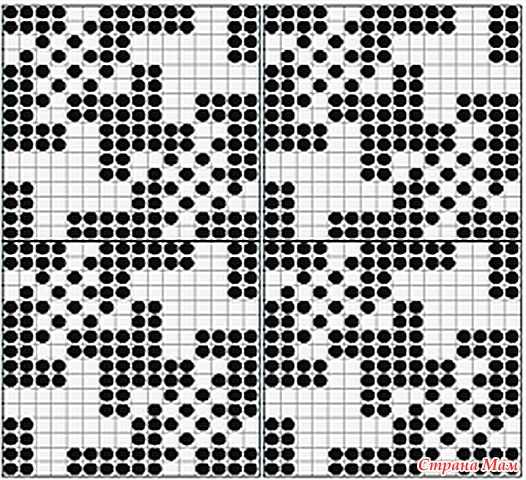
Houndstooth is a classic pattern that has been popular for decades. It is characterized by its distinctive checkered design, made up of small, repeating geometric shapes. The pattern is often seen in black and white, creating a bold and eye-catching look.
Knitting houndstooth can be a fun and rewarding project for experienced knitters. While the pattern may look intricate, it is actually created using a combination of basic knitting stitches, making it accessible to knitters of all skill levels.
To create the houndstooth pattern, knitters will alternate between two colors of yarn, creating small blocks of color that form the checkered design. The pattern can be knitted using either the intarsia or stranded colorwork technique, depending on the desired effect.
One of the great things about knitting houndstooth is that it can be used to create a wide variety of projects. From cozy scarves and hats to stylish sweaters and blankets, the houndstooth pattern adds a touch of elegance to any knitted item. Plus, by choosing different color combinations, knitters can create unique and personalized pieces.
Knit Houndstooth Pattern
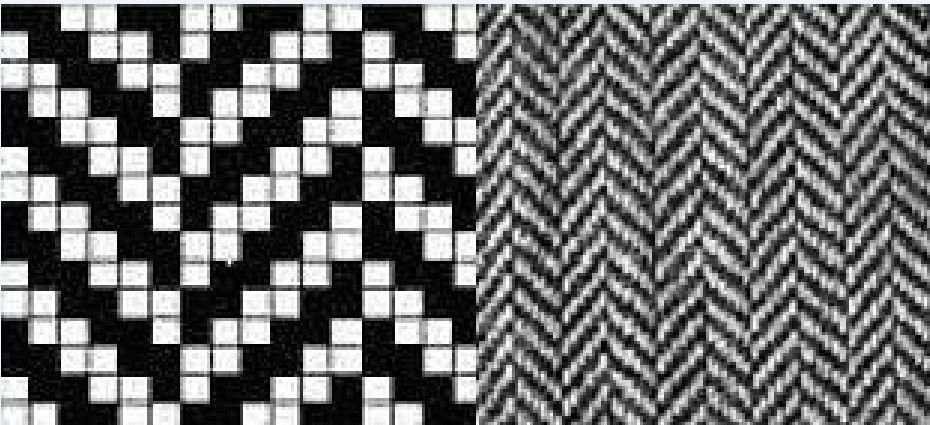
Houndstooth is a classic pattern that adds elegance and sophistication to any knit project. With its distinctive two-color checkered design, houndstooth is a popular choice for sweaters, scarves, hats, and other accessories. Knitting houndstooth pattern requires basic knitting skills and knowledge of colorwork techniques.
To knit houndstooth, you will need two different colored yarns, preferably in contrasting shades to create a bold and eye-catching effect. Generally, a lighter color is used for the background, while a darker color is used for the checks. The pattern is worked by alternating between the two colors, creating a series of small squares that form the houndstooth design.
One way to knit houndstooth is by using the stranded knitting technique, also known as Fair Isle knitting. In this technique, both yarns are carried along the back of the work, creating floats on the wrong side. It’s important to keep the floats loose to prevent the fabric from puckering. Additionally, it’s recommended to catch the floating yarn every few stitches to secure it and prevent long floats that could snag.
Another method to knit houndstooth is by using the intarsia technique. With intarsia, each color block is worked separately, and the yarn is twisted at the color change to prevent holes. This technique is ideal for larger houndstooth designs or when working on projects with more complex colorwork.
Overall, knitting houndstooth pattern can be an enjoyable and rewarding project for knitters looking to challenge themselves and create a timeless and stylish piece. Whether you choose to use the stranded knitting or intarsia technique, the houndstooth pattern is sure to impress and make a statement in your knitted creations.
What is Houndstooth Pattern
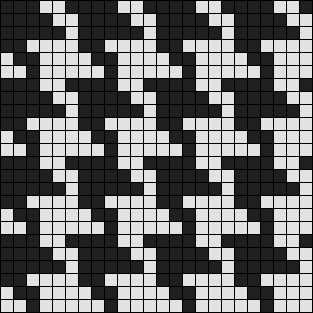
The houndstooth pattern is a classic design that originated in Scotland. It is characterized by a two-tone, broken check pattern that resembles the teeth of a dog, hence its name. The pattern typically consists of alternating bands of contrasting colors, usually black and white or another combination of neutral colors.
The houndstooth pattern has been popularly used in fashion and textiles, especially in tailored clothing such as suits, coats, and skirts. It has a timeless appeal and adds a touch of sophistication and elegance to any garment or accessory. The pattern can be seen in both traditional and contemporary designs, making it versatile and adaptable to different styles and trends.
The houndstooth pattern is also commonly used in knitting and crochet projects. Knitters often create intricate houndstooth patterns using two contrasting yarn colors, usually in the form of small squares or diagonally alternating lines. This technique requires careful attention to detail and precision in creating the stitches to achieve the desired houndstooth effect.
To create a houndstooth pattern in knitting, one can use different techniques such as stranded colorwork or slip stitch patterns. Stranded colorwork involves carrying multiple colors of yarn across the back of the work, creating floats on the wrong side. Slip stitch patterns, on the other hand, involve working with two colors but only using one color on each row, slipping stitches with the other color to create the houndstooth design.
Key Features of Houndstooth Pattern:
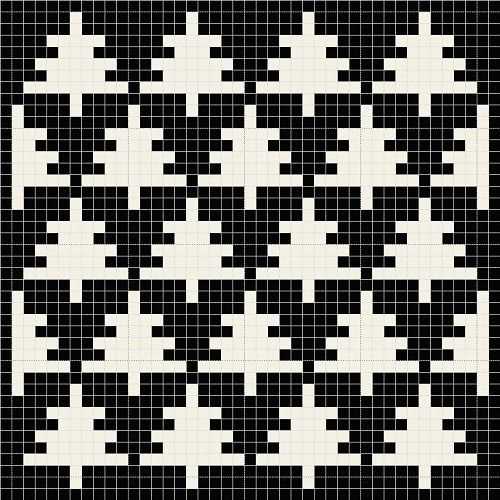
- Two-tone, broken check pattern
- Alternating bands of contrasting colors
- Classic and timeless design
- Used in fashion, textiles, and knitting
- Requires attention to detail and precision
- Can be created using stranded colorwork or slip stitch patterns
Overall, the houndstooth pattern is a versatile and visually appealing design that has stood the test of time. Whether used in fashion or knitting, it adds a touch of sophistication and style to any project.
History of Houndstooth Pattern
The houndstooth pattern, also known as dogtooth or pied-de-poule, has a rich history that dates back hundreds of years. Its origins can be traced to the Scottish Lowlands, where it is believed to have been first woven in the early 19th century. The pattern quickly gained popularity and spread throughout Europe, becoming a symbol of elegance and sophistication.
The name “houndstooth” comes from the distinct shape of the pattern, which resembles the jagged teeth of a dog. This unique design was achieved by interlacing contrasting colors in a twill weave, creating a series of small, pointed shapes. The most common color combination for houndstooth is black and white, although it can also be found in various other color combinations.
The houndstooth pattern became especially popular in men’s fashion, being prominently used in suits, jackets, and accessories. It was associated with traditional English and Scottish tailoring, adding a touch of refinement to men’s attire. Over time, the pattern also made its way into women’s fashion, appearing in dresses, skirts, and even footwear.
Today, houndstooth continues to be a timeless and versatile pattern, favored by fashion designers around the world. It is used not only in clothing but also in home decor, upholstery, and accessories. The houndstooth pattern has stood the test of time, remaining a classic choice for those seeking a stylish and sophisticated look.
Materials and Tools for Knitting Houndstooth Pattern
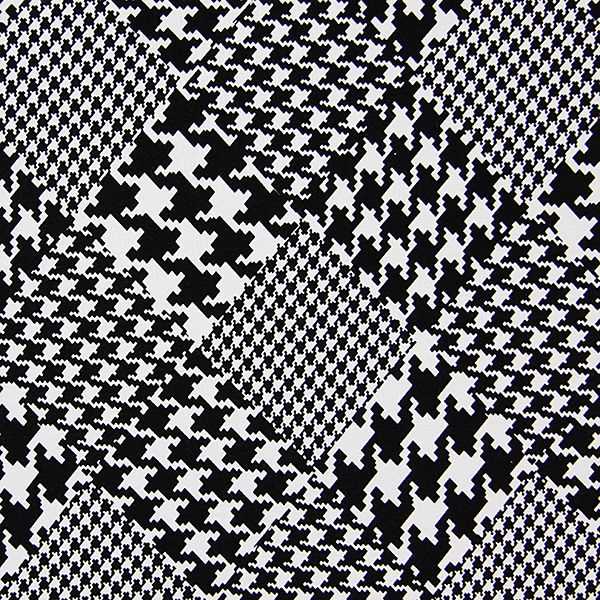
If you want to knit a houndstooth pattern, there are a few materials and tools that you will need to have on hand. Here is a list of the essential items:
- Yarn: Choose two contrasting colors of yarn to create the houndstooth pattern. Ideally, the yarn should be of the same weight and texture to ensure consistent tension throughout the project.
- Knitting Needles: You will need a pair of knitting needles in a size suitable for the chosen yarn. Check the yarn label for recommended needle size or use a needle gauge to determine the appropriate size.
- Stitch Markers: These small plastic or metal rings are used to mark specific stitches or sections in your knitting. They can be handy when working with complex patterns like houndstooth.
- Tapestry Needle: A tapestry needle is used for weaving in loose ends and sewing up any seams. Make sure to choose a needle with a large enough eye to accommodate the yarn.
In addition to these basic materials, you may also find the following tools helpful:
- Row Counter: Keeping track of your rows can be crucial when working on intricate patterns. A row counter can help you stay organized and ensure that you don’t lose your place.
- Scissors: A pair of sharp scissors is essential for cutting yarn and trimming loose ends.
- Blocking Tools: Blocking is the process of shaping and stretching your finished knitted piece to achieve the desired dimensions. Blocking wires, pins, and a blocking mat can be useful for achieving a professional-looking result.
By gathering these materials and tools before you begin your houndstooth knitting project, you can ensure that you have everything you need to create a beautiful and well-crafted pattern.
Basic Knitting Stitches for Houndstooth Pattern
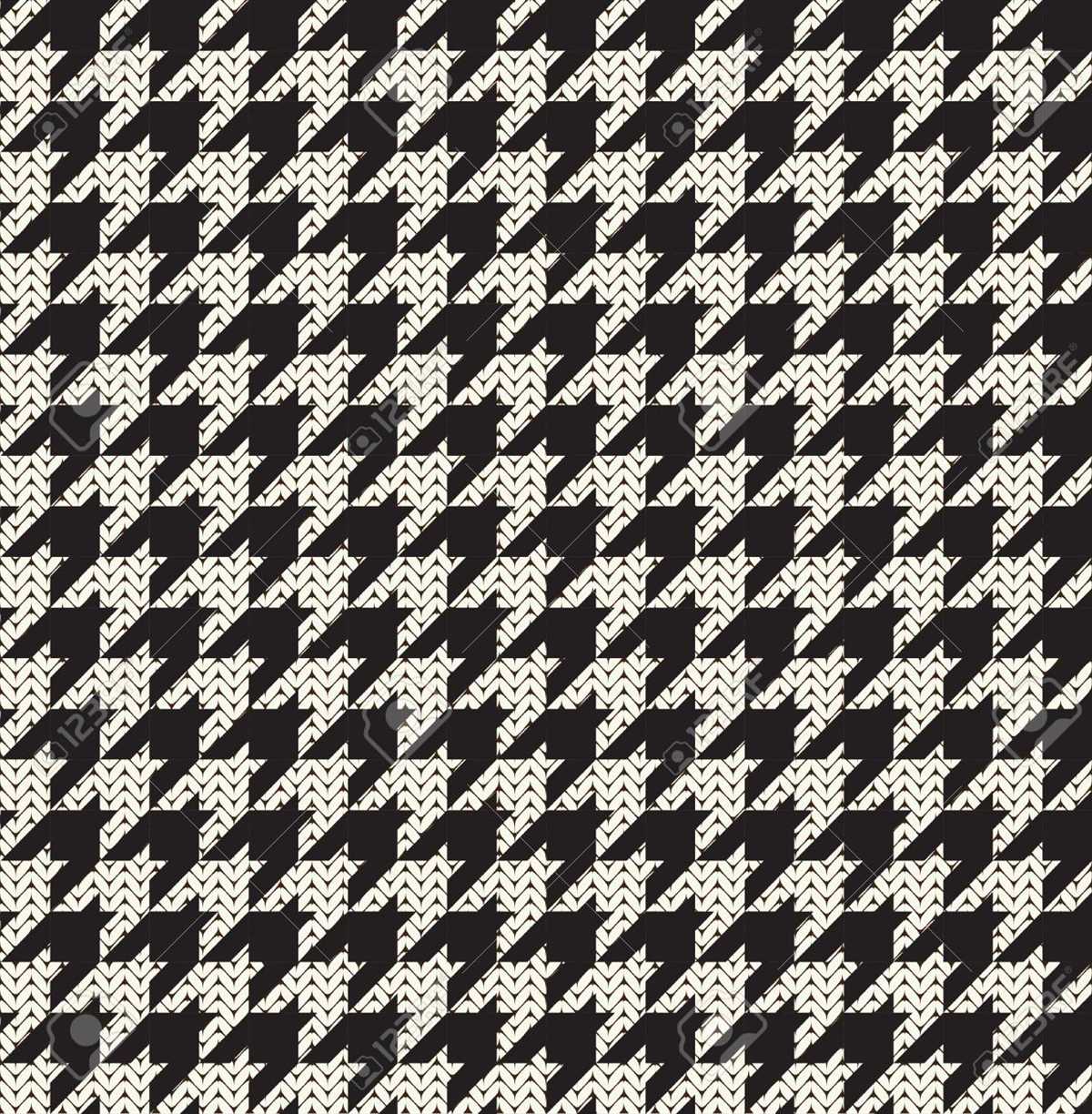
The houndstooth pattern is a classic design that is popular in knitting. It features a repeating pattern of small, interlocking rectangles, creating a checkered effect. To knit the houndstooth pattern, you will need to learn a few basic stitches.
1. Knit Stitch:
The knit stitch is the most basic stitch in knitting. Insert the right needle into the first stitch on the left needle from the bottom to the top. Wrap the yarn around the right needle counterclockwise. Pull the right needle with the loop of yarn through the stitch, sliding the stitch off the left needle. This creates a new stitch on the right needle.
2. Purl Stitch:
The purl stitch is another fundamental stitch in knitting. Insert the right needle into the first stitch on the left needle from the top to the bottom. Wrap the yarn around the right needle clockwise. Pull the right needle with the loop of yarn through the stitch, sliding the stitch off the left needle. This creates a new stitch on the right needle.
3. Slip Stitch:
The slip stitch is used in the houndstooth pattern to create the interlocking rectangles. Insert the right needle into the first stitch on the left needle as if to purl. Instead of wrapping the yarn and pulling it through, simply pass the stitch from the left needle to the right needle without knitting or purling it. This creates a new stitch on the right needle, but does not change the stitch count.
4. Decrease:
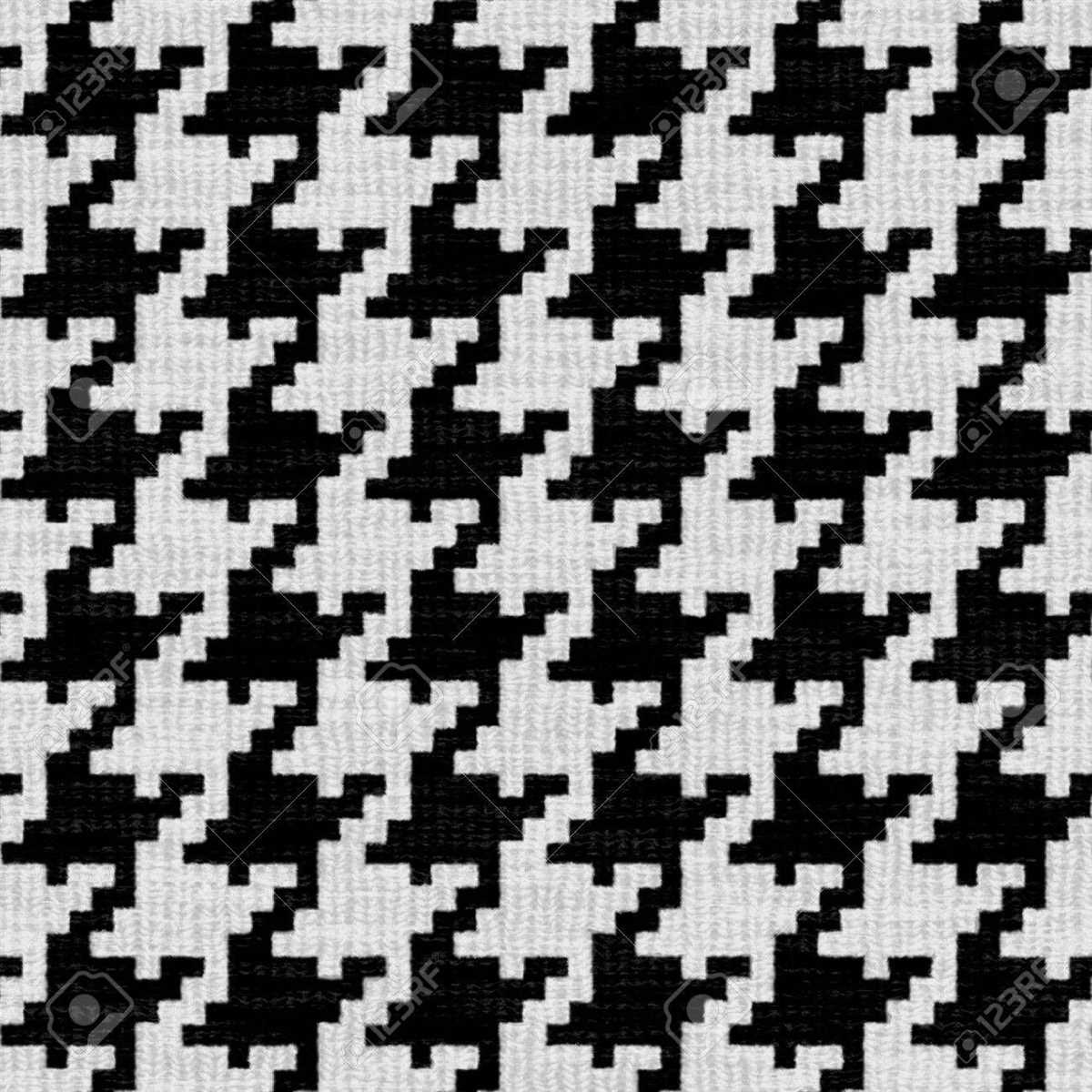
In the houndstooth pattern, decreases are used to create the angles in the rectangles. The most common decrease stitch is the knit two together (k2tog). Insert the right needle into the next two stitches on the left needle as if to knit, then knit them together as one stitch by wrapping the yarn counterclockwise and pulling it through. This reduces the stitch count by one.
By mastering these basic knitting stitches, you will be able to create the houndstooth pattern with ease. Practice your tension and take care to follow the pattern instructions, and you will soon have a beautiful houndstooth project to show off!
Creating the Houndstooth Pattern
The houndstooth pattern is a classic design that is popular in the world of knitting. It features a distinctive checkered pattern that resembles the tooth of a hound. Creating this pattern requires attention to detail and an understanding of how to create the alternating colors.
To create the houndstooth pattern, you will need two colors of yarn: one for the background and one for the checks. Start by casting on an even number of stitches in the background color. Then, follow the chart or pattern instructions to work the required number of rows in the background color.
Next, it’s time to introduce the contrasting color. Switch to the check color yarn and follow the chart or pattern instructions to start working the check pattern. The check pattern is created by alternating between knitting and purling stitches in the check color. Pay close attention to the chart or pattern for the specific instructions on when to knit and when to purl.
Continue working the check pattern for the required number of rows, following the instructions on the chart or pattern. Once you have completed the check pattern, switch back to the background color and work the required number of rows in this color.
Repeat the process of switching between the background and check colors, following the chart or pattern instructions, until the desired length or size is reached. Remember to always keep track of where you are in the pattern and to follow the instructions closely to maintain the houndstooth design.
Creating the houndstooth pattern requires patience and attention to detail, but the end result is a beautiful and timeless design that will impress anyone who sees your finished project.
Tips and Tricks for Knitting Houndstooth Pattern
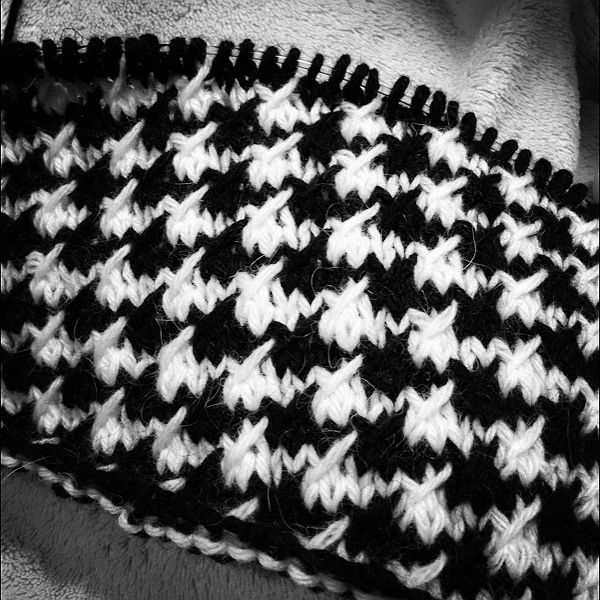
Knitting the houndstooth pattern requires some precision and attention to detail. Here are a few tips and tricks that can help you achieve the desired pattern and avoid common mistakes.
1. Choose the right yarn: The houndstooth pattern looks best when knit with a smooth, medium-weight yarn. Avoid using variegated or textured yarns, as they can distract from the pattern.
2. Use contrasting colors: The signature houndstooth pattern is created by alternating two colors. Make sure to choose colors that have a high contrast, such as black and white or navy blue and cream. This will help the pattern stand out.
3. Tension is key: Maintaining an even tension is crucial when knitting houndstooth. Uneven tension can result in an inconsistent pattern. Take your time and check your tension frequently to ensure an even and neat fabric.
4. Pay attention to the stitch count: Houndstooth patterns usually have a multiple of four stitches for the repeat. Make sure to cast on the correct number of stitches to maintain the integrity of the pattern. Double-check your stitch count before proceeding.
5. Be mindful of your floats: Houndstooth patterns often involve carrying the unused color along the back of your work. Be careful not to pull the floats too tightly, as this can create puckering in the fabric. Aim for a relaxed tension when working with floats.
6. Block your finished project: Blocking is essential to enhance the overall appearance of your houndstooth fabric. It helps even out stitches and gives the pattern a crisp and polished look. Follow the blocking instructions for your chosen yarn to achieve the best result.
With these tips and tricks in mind, you’ll be well-equipped to tackle houndstooth patterns with confidence. Happy knitting!
Color Variations for Houndstooth Pattern
Houndstooth pattern, also known as dogtooth or pied-de-poule, is a classic textile design characterized by a two-tone broken check pattern. While the traditional houndstooth pattern is often seen in black and white, it can be reimagined in various color combinations to suit different styles and preferences. Color plays a significant role in transforming the look and feel of the houndstooth pattern, making it adaptable for a wide range of applications.
1. Classic Black and White: The timeless combination of black and white is the most iconic choice for the houndstooth pattern. This monochromatic color scheme exudes elegance and sophistication, making it a popular choice for formal attire, such as suits and dresses. The high contrast between black and white enhances the distinctive geometric pattern, creating a bold and eye-catching visual impact.
Variations with Bold Colors:
- 2. Vibrant Red and Black: Adding a pop of color to the houndstooth pattern can create a striking and modern look. Combining vibrant red with black creates a bold, confident, and fierce appearance. This color variation is often used in fashion-forward designs, such as coats, skirts, and accessories, to make a bold fashion statement.
- 3. Subtle Pastels: Soft pastel colors can provide a delicate and feminine twist to the houndstooth pattern. Combining light shades of pink, blue, or lavender with white or gray creates a gentle and romantic aesthetic. This color variation is often seen in women’s clothing, such as blouses, scarves, and skirts, adding a touch of elegance and sophistication to the pattern.
- 4. Earthy Neutrals: Neutral tones, such as beige, brown, and taupe, can give the houndstooth pattern a more subdued and organic feel. This color variation is versatile and can be used in both casual and formal designs. Earthy neutrals lend a sense of warmth and coziness, making them an ideal choice for sweaters, blankets, and home decor items.
By exploring different color variations, the houndstooth pattern can be adapted to suit various design preferences and applications. Whether it’s classic black and white, vibrant red and black, subtle pastels, or earthy neutrals, the color choices can elevate the houndstooth pattern to new heights of creativity and versatility.
Using Houndstooth Pattern in Different Knitting Projects
If you’re a fan of classic patterns, the houndstooth pattern is a must-have in your knitting arsenal. The houndstooth pattern, characterized by its distinctive broken checkered design, adds instant sophistication and timeless appeal to any knitting project. Whether you’re a beginner or an experienced knitter, incorporating the houndstooth pattern into your projects is a fun and rewarding way to showcase your knitting skills.
Scarves and Shawls: One of the most common ways to use the houndstooth pattern in knitting is to create scarves and shawls. The repetitive nature of the pattern makes it ideal for creating long, narrow pieces that showcase the houndstooth design. Knitting a houndstooth scarf or shawl is a great way to add a touch of elegance to your outfit while keeping warm during colder months.
Sweaters and Cardigans: Another popular application of the houndstooth pattern is in the creation of sweaters and cardigans. The graphic design of the houndstooth pattern can add visual interest to any garment, making it a stylish choice for knitting projects. Whether you opt for a full houndstooth sweater or incorporate the pattern as a subtle accent, the houndstooth design is sure to elevate your knitted creations to the next level.
Hats and Gloves: If you’re looking for smaller knitting projects, hats and gloves are perfect for showcasing the houndstooth pattern. The design lends itself well to accessories like hats and gloves, as the smaller size allows for intricate detail. Knitting a houndstooth hat or pair of gloves can be a fun and challenging project that results in a unique and fashionable accessory.
Home Decor: The houndstooth pattern is not limited to clothing items. It can also be used to create beautiful and stylish home decor pieces. From pillows to blankets, incorporating the houndstooth pattern into your home decor can add a touch of sophistication to any room. Whether you choose to knit a houndstooth throw blanket or create houndstooth patterned pillow covers, these pieces will surely impress your guests.
With its timeless appeal and versatility, the houndstooth pattern is a popular choice for a wide range of knitting projects. Whether you choose to knit scarves, sweaters, accessories, or home decor items, incorporating the houndstooth pattern will add a touch of sophistication and elegance to your creations. So grab your knitting needles and start experimenting with this classic pattern today!
Caring for Knitted Houndstooth Garments

Knitted houndstooth garments require special care to ensure they retain their shape and appearance. Follow these guidelines to keep your items looking their best:
1. Handwashing
To preserve the integrity of the houndstooth pattern, it is recommended to handwash knitted houndstooth garments. Fill a basin or sink with lukewarm water and add a mild detergent specifically designed for delicate fabrics. Gently submerge the garment and use your hands to agitate the water, ensuring the soap reaches all areas of the fabric. Avoid twisting or wringing the garment to prevent stretching or distortion of the pattern. Rinse thoroughly in cool water until the soap is completely removed.
2. Drying
After handwashing, avoid ringing out the garment. Instead, gently press out excess water using a clean towel. Lay the garment flat on a clean, dry towel or a mesh drying rack, shaping it back into its original form. Avoid hanging knitted houndstooth garments as this can cause them to stretch and lose their shape. Allow the garment to air dry completely before storing or wearing.
3. Storage
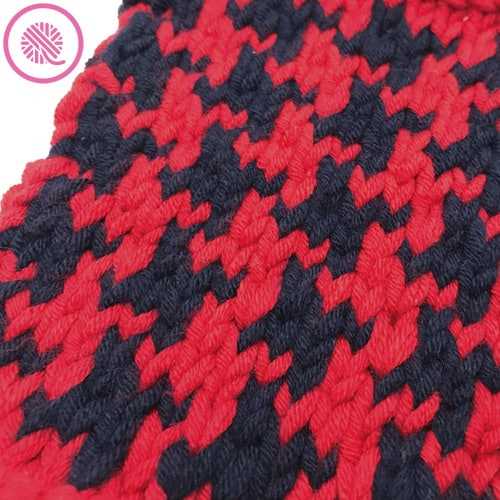
When storing knitted houndstooth garments, fold them neatly to avoid any unnecessary stretching or creasing. It is best to store them in a cool, dry place away from direct sunlight, as prolonged exposure to sunlight can cause fading or discoloration. To further protect the garment, you can place it in a cotton or linen bag to prevent dust accumulation.
By following these care guidelines, you can ensure your knitted houndstooth garments remain in excellent condition and can be enjoyed for years to come.
Inspiration for Knitting Houndstooth Pattern
Knitting houndstooth pattern can be a great way to add a classic and timeless touch to your knitwear. Whether you are looking to create a cozy scarf, a stylish sweater, or even a pair of socks, the houndstooth pattern is versatile and can be adapted to fit various knitting projects.
If you are in need of some inspiration, here are a few ideas to help you get started:
- Traditional Houndstooth: Stick to the classic black and white color palette to create a traditional houndstooth pattern. This timeless combination is perfect for adding a touch of sophistication to any knitwear.
- Colorful Houndstooth: Get creative with your color choices and experiment with different shades to create a unique and vibrant houndstooth pattern. From bold and bright color combinations to subtle and muted tones, the possibilities are endless.
- Houndstooth Accessories: Consider knitting houndstooth pattern into smaller accessories, such as hats, headbands, or even mittens. These smaller projects can be a great way to practice the pattern and add a touch of style to your winter wardrobe.
- Textured Houndstooth: Combine the houndstooth pattern with other knitting techniques, such as cables or lace, to add texture and depth to your knitwear. This can create a more intricate and eye-catching design.
- Striped Houndstooth: Incorporate stripes into your houndstooth pattern for a unique twist. Play around with different stripe widths and colors to create a pattern that is truly your own.
No matter how you choose to incorporate the houndstooth pattern into your knitting projects, the key is to have fun and experiment with different variations. With its timeless appeal and versatility, the houndstooth pattern is sure to add a touch of elegance to your knitted creations.